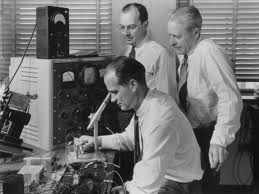 In the last few decades, electronics has become more and more central to our lives. When I was a child the only electronics in the house was the radio and the television, both of which contained tubes. Two big things happened that upended that world: the invention of the transistor and the invention of the integrated circuit. A modern integrated circuit, or chip as some people like to call them, may have over a billion transistors on it and yet sell for just a few dollars. Perhaps more surprising, every one of those transistors works correctly.
In the last few decades, electronics has become more and more central to our lives. When I was a child the only electronics in the house was the radio and the television, both of which contained tubes. Two big things happened that upended that world: the invention of the transistor and the invention of the integrated circuit. A modern integrated circuit, or chip as some people like to call them, may have over a billion transistors on it and yet sell for just a few dollars. Perhaps more surprising, every one of those transistors works correctly.
As a result, today our cell phones have more power than the supercomputers of yesteryear. Our cars contain dozens of microprocessors. We shop online. We read books on our Kindles or iPads. We play videogames on consoles that are more powerful than the flight simulators of twenty years ago.
Like the comedian who rehearses intensely until it all looks ad-libbed, as it turns out it is really expensive to make electronics that cheap. Chips are built in factories known as fabs (actually short for fabrication line). Fabs cost more than nuclear power plants. They are filled with specialized machines costing tens of millions of dollars each. Chips are designed by teams of hundreds of design engineers and they are surrounded by an ecosystem of specialized software that sells for tens if not hundreds of thousands of dollars per copy without which these chips wouldn’t be possible.
Designing a chip and getting it manufactured is a bit like the pharmaceutical industry. Getting to the stage that a drug can be shipped to your local pharmacy is enormously expensive but when you are done you have something that can be manufactured for a few cents and sold for, perhaps, ten dollars. A chip is like that (although for different reasons). Getting a chip designed and manufactured is incredibly expensive, but when you are done you have something that can be manufactured for a few dollars and enable products that can be sold for hundreds of dollars. The first chip may cost millions of dollars but you can make hundreds of millions of dollars if you sell a lot of them.
So let’s go back to the beginning:
The transistor was invented at Bell Labs in New Jersey in 1947 by John Bardeen, Walter Brattain and William Shockley. The transistor is at the heart of almost all electronics and so it is one of the most important inventions of the 20[SUP]th[/SUP] century. Shockley fell out of favor with Bell Labs and returned to Palo Alto where he had been brought up. He opened the Shockley Semiconductor Laboratory of Beckman Instruments and tried to lure ex-colleagues from Bell Labs to join him. When he was unsuccessful, he searched universities for the brightest young graduates to build the new company. This was truly the genesis of Silicon Valley and some of its culture that still exists today. Shockley is credited with bringing the silicon to Silicon Valley.
Shockley’s management style was abrasive and caused dissension in the ranks but the final straw was when Shockley decided to discontinue research into silicon-based transistors. Eight people, known as the traitorous eight, resigned and with seed money from Fairchild Camera and Instrument they created Fairchild Semiconductor Company. Almost all semiconductor companies, especially Intel, AMD and National Semiconductor (now part of Texas Instruments), have their roots in Fairchild in one way or another. It was where silicon based integrated circuits began, which as it turns out, is the prevailing technology still in use today.
The second big step, the invention of the integrated circuit, took place simultaneously at Fairchild and Texas Instruments from 1957 to 1959. Jean Hoerni at Fairchild developed the planar transistor then Jack Kilby at Texas Instruments and Robert Noyce at Fairchild developed the integrated circuit.
This turned out to be the big breakthrough. Until that point transistors were built one at a time and wired together manually. The planar manufacturing process allowed multiple transistors to be created simultaneously and connected together simultaneously. By 1962 Fairchild was producing integrated circuits with about a dozen transistors. Much has changed in the intervening years but this same basic principle is how we build today’s chips with billions of transistors.
So those two inventions, the transistor and the integrated circuit, really are the key to electronics today and the ways in which semiconductors affects our lives.
A Brief History of Semiconductors
A Brief History of Moore’s Law
A Brief History of ASICs
A Brief History of Programmable Devices
A Brief History of the Fabless Semiconductor Industry
A Brief History of TSMC
A Brief History of EDA
A Brief History of Semiconductor IP
A Brief History of SoCs










Quantum Computing Technologies and Challenges